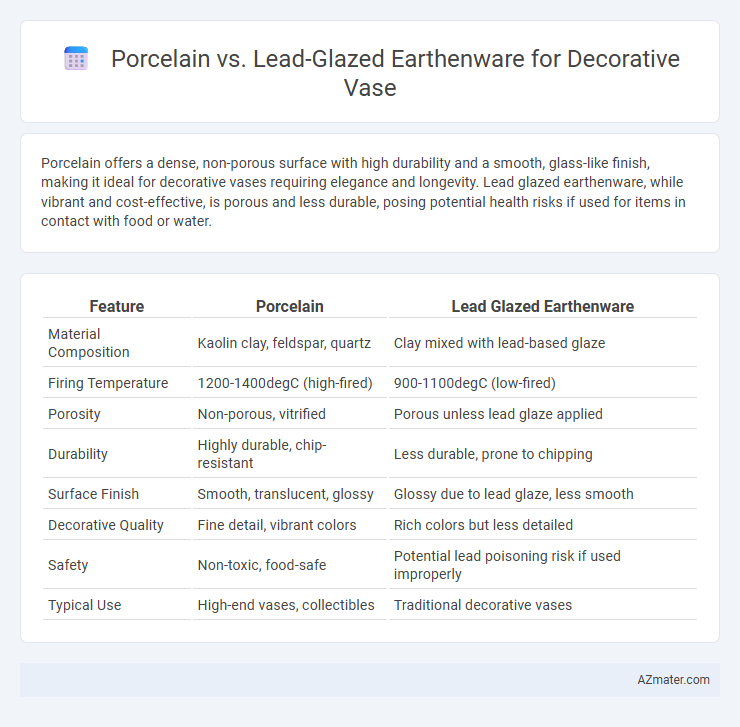Porcelain offers a dense, non-porous surface with high durability and a smooth, glass-like finish, making it ideal for decorative vases requiring elegance and longevity. Lead glazed earthenware, while vibrant and cost-effective, is porous and less durable, posing potential health risks if used for items in contact with food or water.
Table of Comparison
| Feature | Porcelain | Lead Glazed Earthenware |
|---|---|---|
| Material Composition | Kaolin clay, feldspar, quartz | Clay mixed with lead-based glaze |
| Firing Temperature | 1200-1400degC (high-fired) | 900-1100degC (low-fired) |
| Porosity | Non-porous, vitrified | Porous unless lead glaze applied |
| Durability | Highly durable, chip-resistant | Less durable, prone to chipping |
| Surface Finish | Smooth, translucent, glossy | Glossy due to lead glaze, less smooth |
| Decorative Quality | Fine detail, vibrant colors | Rich colors but less detailed |
| Safety | Non-toxic, food-safe | Potential lead poisoning risk if used improperly |
| Typical Use | High-end vases, collectibles | Traditional decorative vases |
Introduction to Decorative Vase Materials
Porcelain offers a refined, translucent quality with a smooth, durable surface ideal for decorative vases that require elegance and longevity. Lead glazed earthenware provides a vibrant, glossy finish with rich color variations but may be more porous and less durable over time. Understanding the material properties of porcelain and lead glazed earthenware helps in selecting the appropriate vase for aesthetic appeal and functional use.
Overview of Porcelain Vases
Porcelain vases, renowned for their translucency and strength, are crafted from refined kaolin clay fired at high temperatures above 1200degC, resulting in a dense, non-porous body ideal for decorative purposes. These vases exhibit a smooth, glass-like finish that resists chipping and discoloration, distinguishing them from lead glazed earthenware which often has a more porous, softer texture due to lower firing temperatures. Porcelain's durability and ability to maintain intricate designs with vibrant glazes make it a preferred choice for high-end decorative vases used in both traditional and contemporary interiors.
Characteristics of Lead Glazed Earthenware
Lead glazed earthenware features a porous clay body covered with a lead-based glaze that provides a glossy, smooth surface but remains less durable and more porous than porcelain. This material is more prone to chipping and staining, making it suitable mainly for decorative vases rather than functional uses. Its lower firing temperature and ease of shaping allow for intricate designs and vibrant glaze colors, enhancing decorative appeal.
Aesthetic Differences: Porcelain vs Lead Glazed Earthenware
Porcelain vases are characterized by their smooth, translucent surface and refined, delicate appearance, offering a high-gloss finish that emphasizes intricate details and vibrant colors. Lead glazed earthenware displays a more rustic and earthy aesthetic with a thicker, heavier glaze that often results in a warmer, matte or semi-gloss appearance, highlighting handcrafted imperfections. The translucency and lightness of porcelain contrast sharply with the dense, opaque quality of lead glazed earthenware, influencing the overall decorative appeal and style of the vase.
Durability and Longevity Comparison
Porcelain offers superior durability and longevity compared to lead glazed earthenware due to its higher firing temperature and denser, vitrified body that resists chipping and cracking. Lead glazed earthenware, while visually appealing, is more porous and prone to surface wear, which diminishes its lifespan over time, especially under physical stress or environmental changes. Choosing porcelain ensures a decorative vase maintains structural integrity and aesthetic quality for decades with minimal maintenance.
Safety and Toxicity Concerns
Porcelain is a non-porous ceramic fired at high temperatures, making it naturally safer and less likely to leach harmful substances compared to lead glazed earthenware, which often contains lead and requires careful glazing and firing to prevent toxic exposure. Lead glazed earthenware poses significant health risks if the glaze is improperly formulated or damaged, as lead can leach into water or food, raising serious toxicity concerns especially when used for decorative vases that may come into contact with living environments. Choosing porcelain for decorative vases minimizes safety hazards due to its chemical stability and compliance with modern safety standards restricting lead content in ceramics.
Maintenance and Cleaning Requirements
Porcelain vases require minimal maintenance due to their non-porous, vitrified surface that resists stains and moisture, making cleaning simple with mild soap and water. Lead glazed earthenware demands more careful handling since its porous body beneath the glaze can absorb moisture and stains if the glaze cracks, necessitating gentle cleaning and avoiding harsh chemicals. Regular inspection for glaze integrity is crucial in lead glazed earthenware to prevent damage and maintain its decorative appeal.
Cost and Accessibility of Each Material
Porcelain offers a high-end, durable option for decorative vases but tends to be more expensive and less accessible due to its complex manufacturing process. Lead glazed earthenware provides a more affordable alternative with easier availability, though it carries potential health risks and lower durability. Budget-conscious buyers often prefer lead glazed earthenware for its cost-effectiveness despite the trade-offs in longevity and safety.
Popular Styles and Design Trends
Porcelain vases are prized for their smooth, translucent finish and intricate hand-painted patterns, popular in styles like Chinese blue and white and European Rococo, emphasizing elegance and fine detail. Lead glazed earthenware offers a rustic charm with its thicker, colorful glazes and artisanal textures, favored in folk art and mid-century modern designs that highlight earthy tones and organic shapes. Current design trends lean towards combining both materials' aesthetic qualities to create decorative vases that balance durability with artistic expression.
Choosing the Right Material for Your Decorative Vase
Porcelain offers a durable, non-porous surface with a translucent appearance, ideal for high-end decorative vases that require elegant finishes and resistance to moisture. Lead glazed earthenware provides vibrant colors and a glossy finish but may pose health risks due to lead content and is less durable than porcelain. Selecting the right material depends on balancing aesthetic preferences, safety considerations, and long-term durability for your decorative vase.

Infographic: Porcelain vs Lead Glazed Earthenware for Decorative Vase
 azmater.com
azmater.com